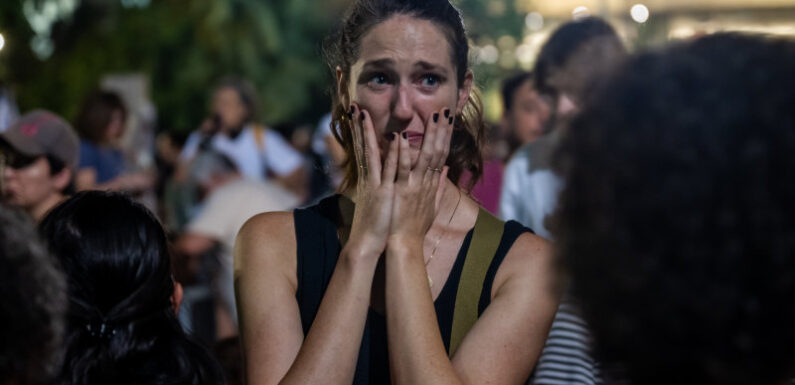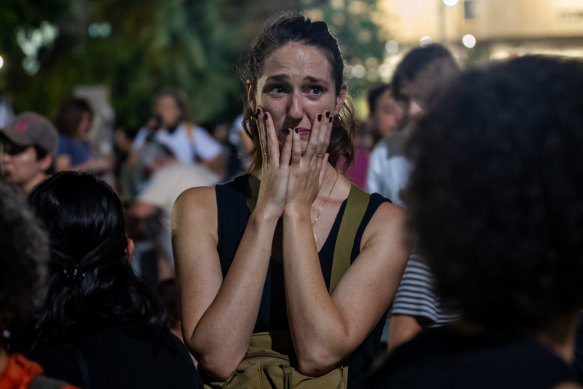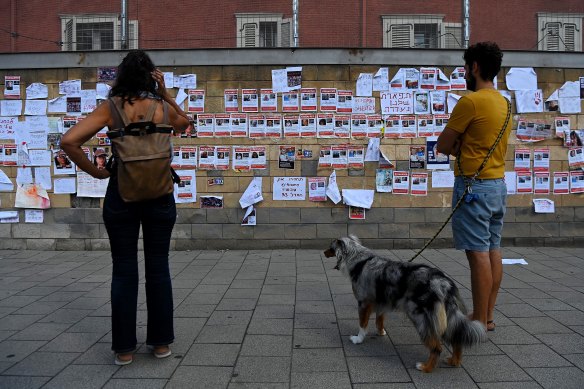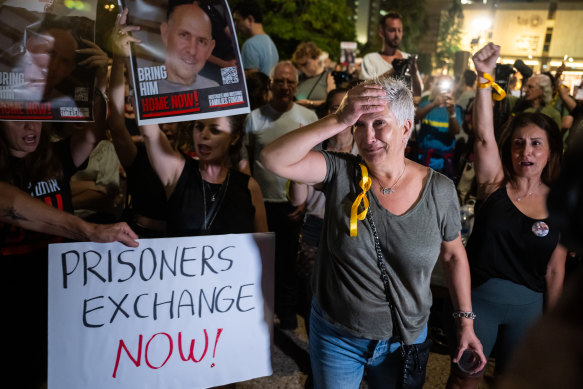
Save articles for later
Add articles to your saved list and come back to them any time.
Jerusalem: The Israeli military has sought to assure the public it can achieve the two goals of its war on Hamas simultaneously — toppling the strip’s militant rulers and rescuing some 230 hostages abducted from Israel.
But as the army ramps up airstrikes and ground incursions on the blockaded enclave, laying waste to entire neighbourhoods in preparation for a broader invasion, the anguished families of hostages are growing increasingly worried those aims will collide — with devastating consequences.
Families of the hostages, and their supporters, hold a rally at the Tel Aviv Museum Plaza.Credit: Getty
Annihilating Hamas would seem to require a ground operation of unprecedented intensity fraught with the risk of harming Israeli hostages. Saving hostages stuck inside Gaza would appear to require engagement with Hamas, the group that forever traumatised the country when it sent fighters into southern Israel to brutally kill over 1400 people and take dozens captive on Oct. 7, sparking this latest war between the bitter enemies. Over 7700 Palestinians have been killed in the Israeli offensive, according to the Hamas-controlled Gaza Health Ministry.
Israel’s government has not described what a rescue mission could look like. In a televised address late Saturday, Prime Minister Benjamin Netanyahu acknowledged the agony of hostages’ families and promised their release was an “integral” part of Israel’s war effort, on par with its goal of destroying Hamas.
Hamas political leaders are in negotiations with mediators Egypt and Qatar to secure the freedom of at least some trapped Israeli civilians. Four hostages have been released so far.
Anxiety over Hamas’ hostages reached a fever pitch Saturday, as Israel intensified its air campaign and sent troops into Gaza with heavy firepower. Crowds protested outside Israel’s Defence Ministry in Tel Aviv, demanding that Netanyahu and other officials address the fate of their loved ones.
People look at the posters of Israeli hostages taken by Hamas on October 7 in Tel Aviv, Israel.Credit: Kate Geraghty
It worked. Netanyahu met with the families Saturday and vowed to “exercise and exhaust every possibility to bring them home.” Defense Minister Yoav Gallant promised to meet them Sunday for what his office described as the first official meeting with them.
“We are not waiting any longer,” said protester Malki Shem-Tov, whose 21-year-old son, Omer, is being held captive in Gaza. “We want all of them back with us today. We want you, the Cabinet, the government, to imagine that these are your children.”
The plight of the hostages has captured the nation’s attention for the past three weeks. Israeli media are filled with stories about the hostages and interviews with their families.
But all of the military’s options carry enormous risks. A military invasion raises the prospect of intractable warfare in densely populated cities and subterranean tunnels that could suck young soldiers into a monthslong quagmire.
With the hostages believed to be hidden in Hamas’ sprawling tunnel network, heavy fighting raises the prospect of unmitigated chaos for soldiers and hostages alike.
Late on Friday as the Israeli military struck Gaza by air, land and sea with a ferocity never seen before, families of hostages were on edge, acutely aware of the dangers facing their loved ones.
“It was a long and sleepless night,” said Liat Bell Sommer, a spokesperson for the families who she said suffered from “absolute uncertainty regarding the fate of the hostages held there, who were also subject to the heavy bombings.”
The bombardment seemed to send a message to Hamas — if the group thought it could avoid a devastating ground invasion because of the captives in Gaza, it was wrong.
Balancing the families’ interests with the military goal of destroying Hamas has presented a dilemma for Netanyahu, who is already under fire for his government’s failure to prevent the worst attack in Israeli history and to swiftly come to people’s aid that day.
Amos Yadlin, a retired general and former head of Israel’s military intelligence, said the government’s challenge was to satisfy the immense public pressure both to return the hostages safely and wipe out Hamas. He insisted the two goals could be reconciled if the government finds the “right strategy.”
“Both should be handled simultaneously and should support each other,” Yadlin said, without elaborating.
But many experts believe the best strategy to save hostages remains diplomacy.
A relative of a hostage reacts during a rally calling for hostages to be released in the Tel Aviv Museum Plaza.Credit: Getty
Hamas on Saturday offered Israel an exchange — the release of all hostages in Gaza for all Palestinian prisoners held by Israel. The plight of the prisoners is deeply emotional for Palestinians, who widely see the prisoners as freedom fighters.
Israel has a long history of agreeing to lopsided prisoner swaps. In 2011, it freed over 1000 prisoners in exchange for Gilad Schalit, a soldier who was kidnapped and dragged across the border into Gaza. Many of those prisoners, including Hamas’ top leader in Gaza, Yehiya Sinwar, had been convicted in the killings of Israelis.
“If the enemy wants to end this case at once, we are ready for that,” said Abu Obeida, the spokesman for Hamas’ armed wing.
Israeli military spokesperson Rear Admiral Daniel Hagari was evasive. He said Hamas was engaged in the “cynical exploitation” of the anxieties gripping the Israeli public.
But families who saw four women released to Israel last week following complex hostage diplomacy said they weren’t convinced that the Israeli government had their best interests in mind.
“They feel like they’re left behind and no one is really caring about them,” said Miki Haimovitz, a former lawmaker who spoke on behalf of the hostages’ families at Saturday’s protest. “No one is explaining what’s going on.”
AP
More coverage of the Hamas-Israel conflict
- Cascading violence: Tremors from the Hamas attacks and Israel’s response have reached far beyond the border. But what would all-out war in the Middle East look like?
- The human cost: Hamas’ massacre in Israel has traumatised – and hardened – survivors. And in Gaza, neighbourhoods have become ghost cities.
- “Hamas metro”: Inside the labyrinthine network of underground tunnels, which the Palestinian militant group has commanded beneath war-ravaged Gaza for 16 years. The covert corridors have long provided essential channels for the movement of weapons and armed combatants.
- What is Hezbollah?: As fears of the conflict expanding beyond Israel and Hamas steadily rise, all eyes are on the militant group and political party that controls southern Lebanon and has been designated internationally as a terrorist group. How did it form and what does Iran have to do with it?
Get a note direct from our foreign correspondents on what’s making headlines around the world. Sign up for the weekly What in the World newsletter here.
Most Viewed in World
From our partners
Source: Read Full Article


